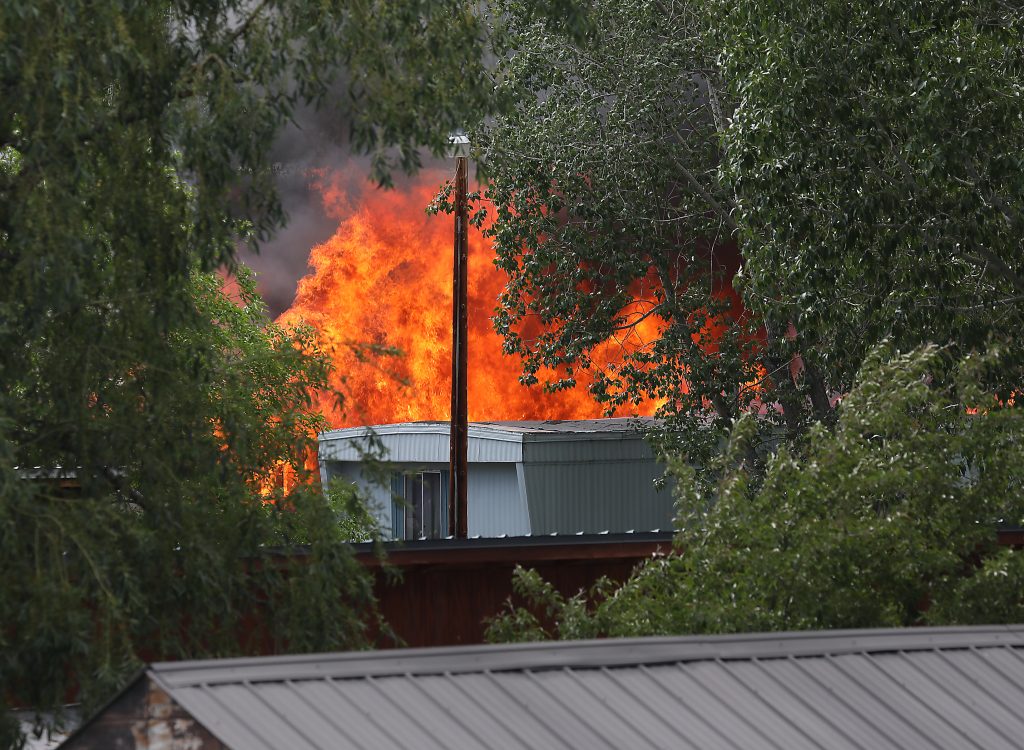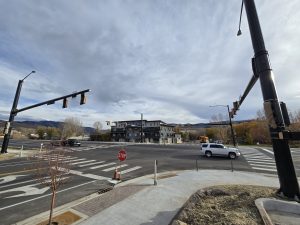More details emerge from fatal plane crash in Steamboat Springs with release of NTSB’s initial report
National Transportation Safety Board probe confirms engine trouble was a factor

John F. Russell/Steamboat Pilot & Today
The pilot of the twin-engine Cessna 421C airplane that crashed into a Steamboat Springs mobile home park last month had reported engine trouble before attempting to land at Bob Adams Field.
According to a preliminary report from the National Transportation Safety Board, the pilot of the airplane, Dan Dunn, 67, took off from Vance Brand Airport in Longmont just after 3 p.m. June 17 with plans to fly to Ogden, Utah.
Dunn and a passenger, Jessica Melton, 42, were killed when the plane slammed into the West Acres Mobile Home Park around 4:20 p.m.
The crash caused the plane and several structures, including two mobile homes, to be fully engulfed in flames. No one on the ground was hurt, and fire crews were able to bring the flames under control shortly after 5 p.m.
Based on an initial review of air traffic control audio transmissions, the NTSB says Dunn reported a “cylinder temperature issue” when the aircraft was in the vicinity of the town of Yampa and requested to divert to Steamboat.
The preliminary findings from the NTSB go on to say Dunn initially overflew the runway and requested to divert the plane to Northern Colorado Regional Airport in Fort Collins, which is roughly 95 miles east of Steamboat.
As the plane headed in the direction of the Fort Collins airport, Dunn reported the loss of the aircraft’s left engine and was subsequently cleared again to land in Steamboat.
“While on the base to the final turn for runway 32, the airplane was observed by witnesses to enter a flat, spiraling descent and impact terrain,” the NTSB report reads. “A post impact fire ensued and consumed a majority of the airplane.”
Investigators noted that “impact signatures were consistent with the airplane impacting in a near horizontal (alignment).”
Witnesses interviewed by the newspaper shortly after the crash seemed to corroborate the initial NTSB findings. West Acres resident Julia Martin said she saw the plane appear to lose engine power before she heard a loud bang.
“I am just sitting outside and I saw the plane, and it was like really low and it seemed like it was kind of stuttering, and then maybe the engine just died,” Martin said. “It was gliding and it seemed like the engine kicked back on and got some momentum, but I think the engine possibly like blew up or something.”
Although consumed by fire, NTSB investigators said an initial examination of the Cessna’s wreckage found both the plane’s engines and all components “relatively attached to the airplane,” with the propeller blades on the left engine appearing “to be in the feathered position.”
The aircraft’s wreckage was retained for further investigation, according to the NTSB report.

Final NTSB investigation could take years
The NTSB is the federal agency responsible for investigating all aviation accidents and incidents.
Preliminary reports from the NTSB are typically released within weeks of a documented aircraft incident and are meant to provide a synopsis of information collected during the on-scene phase of the investigation, according to the agency.
Final NTSB reports, which may determine a cause for an incident, typically take between 18 months and two years before they are released, according to Robert Katz, a commercial pilot and flight instructor with 43 years of experience.
“The thing that takes the longest is sending the engines back to manufacturer,” Katz said. “In this case, it will be Continental (Aerospace Technologies) in Mobile, Alabama, where they have the facilities to tear down these engines, inspect every component part for function, reliability, performance and any failure. Then the engine is reassembled and tested.”
Katz noted the tests from the manufacturer are done under NTSB supervision, but the process “takes a long time because there are literally 100 or more cases waiting for the exact same analysis.”
After reading the preliminary report on the crash in Steamboat, Katz questioned the decision to first divert to Steamboat and then to change plans and head to Fort Collins.
Stressing that it is only his opinion, Katz said the time the pilot spent deciding where to land might have been better used to fly to Yampa Valley Regional Airport in Hayden, which Katz said would have presented an easier approach.
“You most definitely would not want to take an airplane with a sick engine over high terrain (to Fort Collins) when you are already in the vicinity of a very suitable airport in Hayden,” Katz said. “Given the choice, Steamboat is inferior to Hayden.”
Trevor Ballantyne is the editor for the Steamboat Pilot & Today. To reach him, call 970-871-4254 or email him at tballantyne@SteamboatPilot.com.

Support Local Journalism

Support Local Journalism
Readers around Steamboat and Routt County make the Steamboat Pilot & Today’s work possible. Your financial contribution supports our efforts to deliver quality, locally relevant journalism.
Now more than ever, your support is critical to help us keep our community informed about the evolving coronavirus pandemic and the impact it is having locally. Every contribution, however large or small, will make a difference.
Each donation will be used exclusively for the development and creation of increased news coverage.










